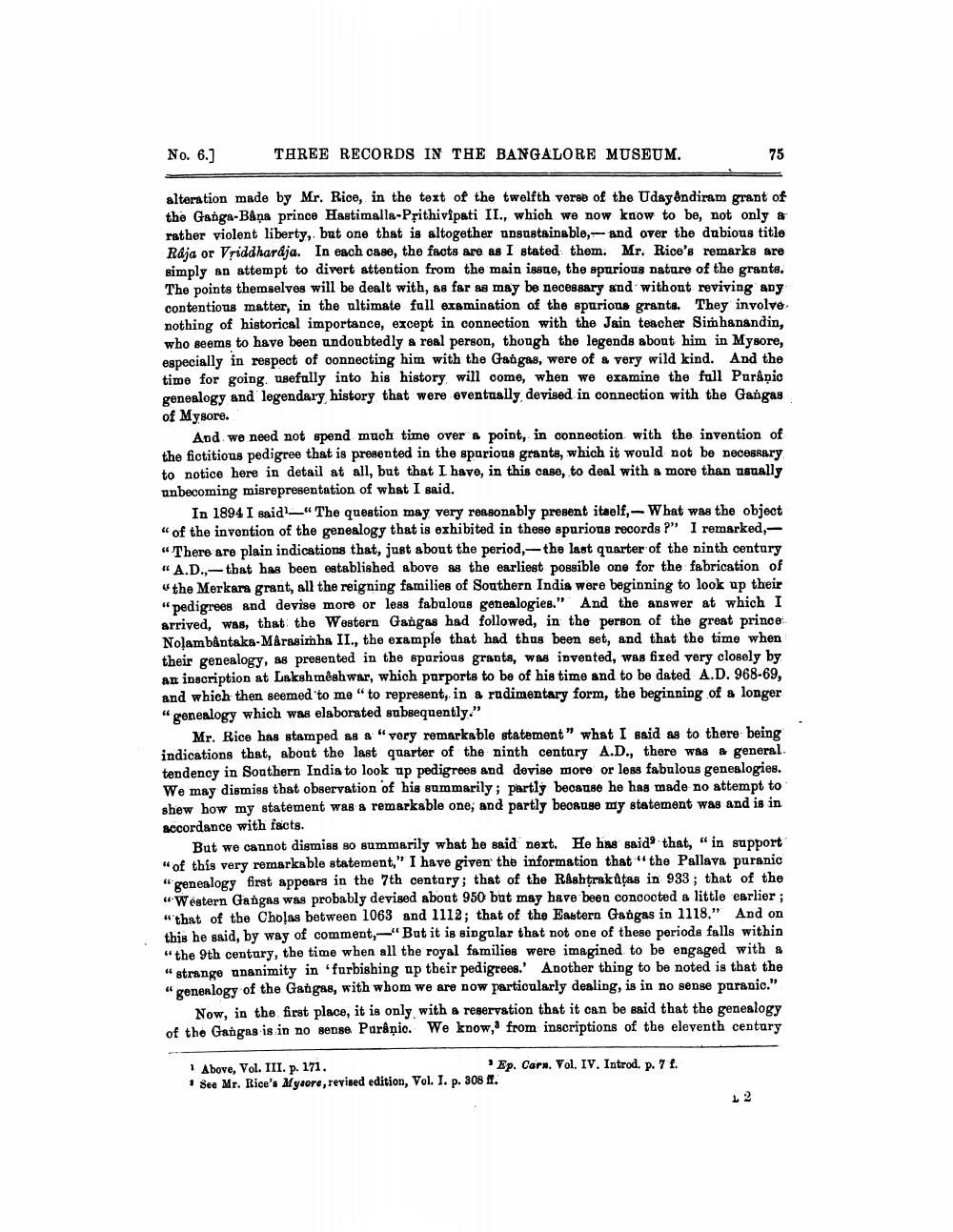________________
No. 6.]
alteration made by Mr. Rice, in the text of the twelfth verse of the Udayêndiram grant of the Ganga-Bapa prince Hastimalla-Prithivipati II., which we now know to be, not only a rather violent liberty, but one that is altogether unsustainable, and over the dubious title Rája or Vriddharaja. In each case, the facts are as I stated them. Mr. Rice's remarks are simply an attempt to divert attention from the main issue, the spurious nature of the grants. The points themselves will be dealt with, as far as may be necessary and without reviving any contentious matter, in the ultimate full examination of the spurious grants. They involve nothing of historical importance, except in connection with the Jain teacher Simhanandin, who seems to have been undoubtedly a real person, though the legends about him in Mysore, especially in respect of connecting him with the Gangas, were of a very wild kind. And the time for going. usefully into his history will come, when we examine the full Purânic genealogy and legendary history that were eventually, devised in connection with the Gangas of Mysore.
THREE RECORDS IN THE BANGALORE MUSEUM.
And we need not spend much time over a point, in connection with the invention of the fictitious pedigree that is presented in the spurious grants, which it would not be necessary to notice here in detail at all, but that I have, in this case, to deal with a more than usually unbecoming misrepresentation of what I said.
75
In 1894 I said "The question may very reasonably present itself,- What was the object "of the invention of the genealogy that is exhibited in these spurious records ?" I remarked,"There are plain indications that, just about the period,-the last quarter of the ninth century "A.D., that has been established above as the earliest possible one for the fabrication of "the Merkara grant, all the reigning families of Southern India were beginning to look up their "pedigrees and devise more or less fabulous genealogies." And the answer at which I arrived, was, that the Western Gangas had followed, in the person of the great prince Nolambântaka-Mârasimha II., the example that had thus been set, and that the time when their genealogy, as presented in the spurious grants, was invented, was fixed very closely by an inscription at Lakshmêshwar, which purports to be of his time and to be dated A.D. 968-69, and which then seemed to me "to represent, in a rudimentary form, the beginning of a longer "genealogy which was elaborated subsequently."
Mr. Rice has stamped as a "very remarkable statement" what I said as to there being indications that, about the last quarter of the ninth century A.D., there was a general. tendency in Southern India to look up pedigrees and devise more or less fabulous genealogies. We may dismiss that observation of his summarily; partly because he has made no attempt to shew how my statement was a remarkable one; and partly because my statement was and is in accordance with facts.
But we cannot dismiss so summarily what he said next. He has said that, "in support "of this very remarkable statement," I have given the information that "the Pallava puranic "genealogy first appears in the 7th century; that of the Rashtrakutas in 933; that of the "Western Gangas was probably devised about 950 but may have been concocted a little earlier; "that of the Cholas between 1063 and 1112; that of the Eastern Gangas in 1118." And on this he said, by way of comment,-"But it is singular that not one of these periods falls within "the 9th century, the time when all the royal families were imagined to be engaged with a "strange unanimity in 'furbishing up their pedigrees.' Another thing to be noted is that the "genealogy of the Gangas, with whom we are now particularly dealing, is in no sense puranic."
Now, in the first place, it is only with a reservation that it can be said that the genealogy of the Gangas is in no sense Purâpic. We know, from inscriptions of the eleventh century
2
Ep. Carn. Vol. IV. Introd. p. 7 f.
1 Above, Vol. III. p. 171. See Mr. Rice's Mysore, revised edition, Vol. I. p. 308 ff.
12




